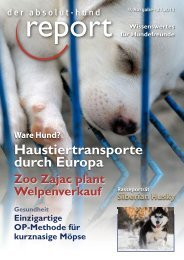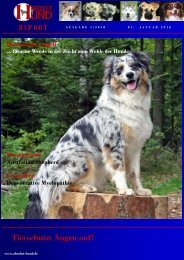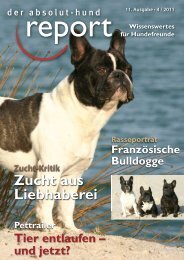Wissenschaft
Wissenschaft
Wissenschaft
Sie wollen auch ein ePaper? Erhöhen Sie die Reichweite Ihrer Titel.
YUMPU macht aus Druck-PDFs automatisch weboptimierte ePaper, die Google liebt.
163 Interaction style qualitative (1: harsh. 5: soft)<br />
164 Interaction style quantitative (1: hardly. 5: intensely)<br />
165 Reaction of dog to threat (1: ignoring. 5: intense)<br />
166 Involvement of owner (1: not. 5: fully attentive to dog)<br />
167 Effort of owner for bridge<br />
168 Achievement for bridge (1: not mastered. 5: perfect)<br />
<strong>Wissenschaft</strong><br />
169 Handling/approach observer (1: avoiding. 5: trusting)<br />
170 Duration (e.g. bridge task) in s (measured)<br />
Dog personality (continuous scale)<br />
171 Sociable–distant<br />
172 Active–inactive<br />
173 Cheerful–not cheerful<br />
einer 174 Summe von 40 Interested–uninterested<br />
ausgewerteten<br />
175 Playful–not playful<br />
Fragebogen 176 führte. Ein Calm–hectic mit den 15 Ele -<br />
177 Wild–gentle<br />
menten 178 des Anhangs Self-confident–uncertain<br />
durchgeführtes<br />
179 Anxious–non-anxious<br />
PCA ( n=40, KMO = 77) offenbart vier<br />
180 Nervous–non-nervous<br />
Achsen: 181 (1) soziale Unterstützung, Dependable–unreliable (2)<br />
182 Calm–vocal<br />
Stärke der Bindung, (3) Qualität der Bin -<br />
dung 185 und (4) der kognitiven Balanced–unbalanced Kompo -<br />
186 Clever–stupid-stubborn<br />
nente 187 (Tabelle 2). Ein Attentive–inattentive<br />
PCA mit den 14<br />
Ele men ten der Hund-Halter-Beziehung<br />
zeigte ebenfalls vier Achsen: (1) ge meinsam<br />
verbrachte Zeit, (2) Ver ant wor tung,<br />
(3) gegenseitige Auf merk sam keit und<br />
(4) gemeinsame Aktivi täten (Tabelle 3).<br />
183 Aggressive–non-aggressive<br />
184 Friendly–unfriendly, not relating to people<br />
To characterize the quality of attachment and of the dyadic relationship,<br />
a questionnaire with 34 items (modified, after Topàl et al.,<br />
1997; Johannson, 1999) wasansweredbytheowners.Itconsisted<br />
of six groups of questions: owner data, owner lifestyle, relationship<br />
owner–dog, dog character/temperament, upbringing, training of<br />
the dog, and dog-related attitudes of the owner. This questionnaire<br />
was answered by the 22 owners participating in full in our study<br />
and by 18 additional owners of intact male dogs, who also took personality<br />
tests but were not tested as a dyad, resulting in a total of<br />
40 respondents. A PCA (n =40, KMO=77) performedwiththe15 2.3 Persönlichkeit des Besitzers<br />
Wir nutzten den NEO-Fünf-Faktoren-In -<br />
ventar (NEO-FFI) um die Persön lich keits-<br />
Table 2 Dimensionen der Besitzer zu erkun den,<br />
tions, conscientiousness rather describes the ability of planning,<br />
organizing and performing in tasks. Persons high on the conscientiousness<br />
scale describe themselves as goal-orientated, ambitious,<br />
diligent, strong-willed, systematic, enduring, tidy and precise, but<br />
may also be compulsive.<br />
Here we simply assume that much of the intrapersonal aspects of<br />
40 the fiveder personality absolut-hund dimension report • 3 are / 2011 also relevant in the interactions<br />
of humans with their companion animals. However, it remains to be<br />
investigated whether persons approach their companion animals in<br />
denn dieser ist ein gut etablierter und<br />
be werteter empirischer Ansatz und zeigt<br />
wichtige und relevante Dimen sionen<br />
der menschlichen Persönlich keit. Dieses<br />
60-Punkte-Instrument misst die normale<br />
erwachsene Persönlichkeit in fünf<br />
Dimensionen, im Folgenden nach dem<br />
abnehmenden Anteil der inter individuellen<br />
Unterschiede aufgereiht conservative. erklärt:<br />
Neurotizismus, Extra ver sion, Offenheit,<br />
Verträglichkeit und Gewis senhaftigkeit<br />
(Tabelle 4). Die folgenden Beschrei bun -<br />
gen gehen auf Borkenau und Ostendorf<br />
(2008) zurück.<br />
Die Neurotizismus-Skala zeigt individuelle<br />
Unterschiede in der emotionalen<br />
Labilität / Stabilität bei gesunden Pro -<br />
ban den. Personen, die hoch auf dieser<br />
todecreasingproportionsofinter-individualvariabilityexplained:<br />
neuroticism, extroversion, openness, agreeableness, and conscientiousness<br />
(Table 4). The following descriptions follow Borkenau and<br />
Ostendorf (2008).<br />
The neuroticism scale depicts individual differences in emotional<br />
lability/stability among healthy human subjects. Individuals<br />
high on this scale frequently experience negative emotions, are<br />
often overwhelmed by them and tend to have unrealistic ideas. In<br />
contrast, emotionally stable persons are calm and balanced even in<br />
stressful situations.<br />
Persons high in extraversion like to be in company of others, they<br />
are self-secure, active, verbally expressive, energetic, cheerful and<br />
optimistic. Introverts (i.e. those low on the extraversion scale) are<br />
controlled, rather than unfriendly, tend to be independent and are<br />
balanced rather than phlegmatic. They enjoy being on their own.<br />
The openness scale measures how interested individuals are in<br />
novel experiences, how intensely they seek and deal with novelty.<br />
Open persons are interested in a wide range of personal and<br />
public matters, are intellectual and creative, are interested in the<br />
arts, are ready to discuss existing norms and ethical, political or<br />
moral values and tend to think and act unconventionally. Persons<br />
with a low score in openness tend to be conventional and<br />
Skala bewertet werden, erleben oft<br />
negative Emotionen, sind oft von ihnen<br />
überwältigt und neigen zu unrealistischen<br />
Ideen. Im Gegensatz dazu sind<br />
emotional stabile Personen auch in<br />
stres sigen Situationen ruhig und ausgeglichen.<br />
Personen mit einem hohen Grad an<br />
Extraversion mögen es, in Gesellschaft<br />
anderer zu sein, sie sind selbstsicher,<br />
aktiv, verbal ausdrucksstark, energiegeladen,<br />
fröhlich und optimistisch. Intro -<br />
vertierte Menschen (das sind die, die<br />
auf der Skala der Extroversion unten an -<br />
ge siedelt sind) sind kontrolliert, aber<br />
nicht unfreundlich, unabhängig und<br />
sind eher phlegmatisch als ausgeglichen.<br />
Sie genießen es, für sich selbst zu sein.<br />
Agreeableness, similar to extraversion primarily describes<br />
intrapersonal behavior. Individuals scoring high in agreeableness<br />
are altruistic, warm, understanding and emphatic and are convinced<br />
that others will respond the same way. They tend to be<br />
trustful, cooperative and forgiving and appreciate harmony in their<br />
relationships. Persons low on this dimension describe themselves<br />
as antagonistic, egocentric and distrustful towards others. They are<br />
competitive rather than cooperative.<br />
Conscientious persons control their impulses, wishes and needs.<br />
Whereas individuals low in neuroticism are in control of their emo-<br />
Factor loadings of the four axes resulting from a PCA with the 15 items in the owner questionnaire relating to owner–dog attachment (n =40, KMO=.77, Bartlett-Test:<br />
chi 2 =400.67,d.f.=105,p .5showninbold.<br />
Degree of owner agreement–disagreement to the following questions F1: Social support F2: Bond strength F3: Bond quality F4: Cognitive component<br />
Only through being together with my dog I feel good .87 .32 .13 0.02<br />
My dogs helps me to keep in balance .81 .27 .18 −.13<br />
IimprovebytalkingtomydogwhenIamsad.Angryorindiscomfort .76 .05 .02 .39<br />
Iliketocareformydog-thedailyroutinesdonotbotherme .69 .09 .28 .49<br />
It feels good to talk to my dog .66 .12 .41 .49<br />
Would be very sad if I would loose my dog or if the dog would be injured or sick .16 .88 .05 .27<br />
IfeelresponsibleformydogandIlikethat .24 .85 .13 .18<br />
My dog means a lot to me .17 .73 .52 .13<br />
My dog is a good pal or friend .28 .59 .56 .18<br />
Do you consider your dog just an animal—full social partner/family animals .22 .20 .80 −.19<br />
How frequently do you talk to your dog? .39 −.03 .70 .32<br />
My dog loves me unconditionally −.07 .25 .69 .38<br />
My dog knows how I feel −.01 .34 −.07 .74<br />
Ibeliefmydogunderstandsme .16 .08 .09 .71<br />
Iammissingmydogwhenwecannotbetogether .19 .18 .25 .61<br />
Tabelle 2: Faktorladungen der vier Achsen, die aus einer PCA der Fragebogen mit den 15 Positionen der Halter zur Hund-Halter-Bindung ( n=40, KMO =<br />
.77, Bartlett-Test: chi2 = 400.67, d.f. = 105, p< .01; Varimax-Rotation. Kaiser-Normalisierung; 75,3% der Variabilität der festgelegten Daten wird von den vier<br />
Achsen erklärt. Alle Belastungen > .5 sind fett dargestellt<br />
K. Kotrschal et al. / Behavioural Processes 81 (2009) 383–391 387<br />
Table 3<br />
Factor loadings of the axes resulting from a PCA with the 14 items of the owner questionnaire relating to owner–dog operational relationship (n =40,KMO=.723,Bartlett-Test:<br />
chi 2 =307.37,d.f.=91,p .5showninbold.<br />
Degree of owner agreement–disagreement to the following questions F1: Time together F2: Responsibility F3: Pay attention F4: Shared activity<br />
Iappreciatespendingmuchtimewithmydog .93 .10 .16 .06<br />
In fact I spend much time with my dog .83 .27 .18 .15<br />
Ilovetocuddlewithmydog .82 .01 .09 −.18<br />
Iwalk/trainmydogforextendedperiodsoftimeseveraltimesperweek .71 .23 .01 .18<br />
Sometimes my dog makes me laugh .64 .47 .18 −.01<br />
Imakesurethatmydogalwayshasaccesstofreshwater .51 .50 .23 −.41<br />
Every day it is my exclusive responsibility to feed my dog .13 .90 .18 −.16<br />
Even at the presence of other family members my dog turns to me when wanting out .16 .79 −.23 .05<br />
Of all family members. It is usually me who walks the dog .25 .74 .23 .21<br />
My dog often demands my attention .14 .22 .77 −.10<br />
Sometimes I spend time with the dog even if I should be busy with other things .17 −.19 .70 .02<br />
How often per day you play with your dog (never–very often) .01 .11 .53 .13<br />
How often do you take your dogs to work, excursions, holidays, shopping, etc. .47 .21 .12 .76<br />
Iliketosimplyhangaroundwithmydogandrelax .57 .24 −.10 −.61<br />
Tabelle 3: Faktorladungen der Achsen, die aus einer PCA mit den 14 Positionen des Eigentümer-Fragebogens zur dyadischen Hund-Halter Beziehung (n=40,<br />
KMO=0,723; Bartlett-Test: chi2 = 307.37, d.f. = 91, p < .001; Varimax-Rotation. Kaiser-Normalisierung: 70,3% Variabilität der festgelegten Daten, die sich durch<br />
die vier Achsen erklärt). Alle Belastungen > .5 sind fett dargestellt<br />
rating on a left-to-right scale was measured and transcribed for further<br />
analysis. The mean value from scorings of the two observers<br />
was used. A PCA was performed on these 17 items (Table 5). This<br />
resulted in four axes: (1) sociable–active; (2) anxious–nervous; (3)<br />
vocal–aggressive; and (4) clever–attentive.<br />
2.5. Salivary hormones








